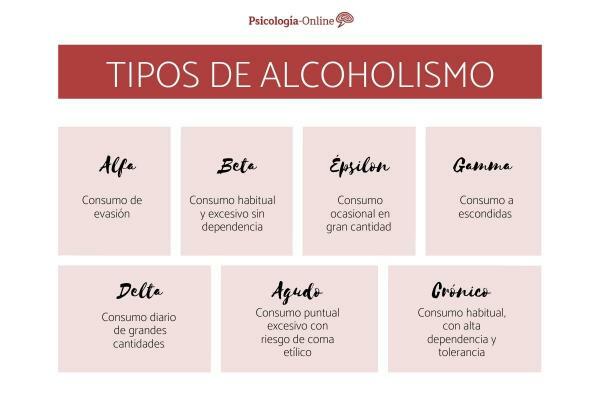
Do you think you can have a problem with alcohol? Do you know someone who in your opinion drinks more than necessary? How many types of alcoholism are there and what are they?
Alcohol is present in our society as a substance of habitual consumption in social gatherings and celebrations. However, a less responsible consumption can generate serious problems for the consumer, both in their health and in social and work relationships. In this Psychology-Online article we explain what the disease of alcoholism is, its symptoms and the types of alcoholism. If you feel identified or identified, do not hesitate to consult a professional specialist.
Index
- What is alcoholism
- Symptoms of alcoholism
- Could you have a problem with alcohol?
- Alpha alcoholic
- Beta alcoholic
- Alcoholic epsilon
- Gamma alcoholic
- Delta alcoholics
- Chronic alcoholism
- Acute alcoholism
- Phases of alcoholism according to Jellinek
What is alcoholism.
The alcoholism is a disease caused by
Continued consumption of alcohol causes physical health problems such as liver cirrhosis, hypertension, gastrointestinal problems, malnutrition, cardiovascular problems and increases the probability of suffering from some types of cancer. Regarding mental health, they may appear mood disorders like depression, accentuate some diseases and even cause brain damage. Also, a large intake can lead to death.
Symptoms of alcoholism.
Alcoholism can range from mild to severe depending on the symptoms, but it is harmful in either case. Symptoms vary from person to person, but are generally as follows:
- Inability to limit the amount of alcohol you consume.
- Desire or attempts that end in failure to reduce the amount of alcohol you consume.
- Spending time drinking or recovering after drinking.
- Strong desire or urge to drink alcohol.
- Failure to comply with work or family responsibilities due to alcohol consumption.
- Continued use of alcohol even when you know it causes health and social problems.
- Abandonment or reduction of social or work activities and hobbies to consume alcohol.
- Consumption of alcohol in situations where it is not safe, such as while driving or swimming.
- Development of tolerance to alcohol, so that you need more amount to feel its effect or you have a reduced effect by the same amount.
- Presence of withdrawal symptoms, such as nausea, sweating, and shaking, when not drinking, or drinking to avoid these symptoms.
- Constant search for alcohol and reasons to drink.
Alcoholism includes episodes of alcohol intoxication and episodes with the presence of withdrawal symptoms.
- Symptoms of poisoning: inappropriate behavior, unstable moods, impaired judgment, difficulty speaking, attention or memory problems, and poor coordination. You can also have so-called blackouts, which are episodes in which you do not remember what happened. Very high levels of alcohol in the blood can lead to coma or even death.
- Withdrawal symptoms- May occur several hours or up to four to five days after a heavy alcohol intake. They consist of sweating, rapid heartbeat, tremors in the hands, problems with sleep, nausea and vomiting, hallucinations, restlessness and nervousness, and anxiety can even occur seizures Symptoms can affect your daily activities.
In this article you can see the Effects of alcohol on the brain and nervous system.
Could you have a problem with alcohol?
We are used to identifying the alcoholic as someone who has been drinking since the morning, who has obvious problems and who spends practically the whole day drunk. But there are many types of alcoholism and some very difficult to identify from the outside. And all of them, whether they are more or less obvious, can cause very serious health problems.
The following questions can guide you on whether or not you need help.
- Have you ever tried to stop drinking for a week and couldn't stick with it?
- Has a family member or friend told you that you drink too much?
- Have you woken up without remembering what had happened the night before?
- Have you ever had a drink in the morning or waited impatiently for the time to get a drink?
- Have you ever been ashamed of your drinking?
- Have you ever been late or missed work because of alcohol or a hangover?
- Have you had a drink at home before a social gathering like a party?
- Have you had arguments or family problems related to alcohol consumption?
If you have answered yes to any of these questions, it is recommended that you consult a professional. Recognizing the problem is the first step in recovering from the disease. In the following article you can read the consequences of alcoholism.
1. Alpha alcoholic.
How many types of alcoholism are there and what are they? Jellinek distinguishes several types of alcoholism in his best-known book "The alcoholic disease": This type of alcoholics have some problem or physical or psychological illness and drink precisely to lessen the effects of their illness (anxiety, depression, insecurity, bipolar disorder, schizophrenia…). He does not follow social norms regarding time, quantity, place and yet he does not show lack of control or inability to abstain. This type is also known as evasion consumption and can evolve to gamma.
2. Beta alcoholic.
Another type of alcoholism according to the Jellinek classification is beta. In this type of alcoholism are people who drink regularly and excessively, but do not develop a total dependence on alcohol. They can drink for a long time, leave it for long periods, and then drink again. As they do not have dependency, they do not have withdrawal symptoms, but they do develop health problems such as liver cirrhosis, gastritis, and the like. This type can lead to gamma or delta and presents a general deterioration in health and a decrease in life expectancy.
3. Epsilon alcoholic.
In the third type of alcoholism according to Jellinek, the person stops drinking for long periods, but if a clear explanation drinks large amounts of alcohol at specific times. It's a more punctual consumption but when he drinks he runs risk of ethyl coma due to the quantity.
4. Gamma alcoholic.
People in this group do not look like alcoholics because hide their addiction. They seem to be drinking normally, but then alcohol-related health problems start to appear. Dependence starts out psychological and then becomes physical due to withdrawal symptoms.
5. Delta alcoholics.
The last type of alcoholism according to Jellinek is delta. Those belonging to this group they drink a lot and daily. They have developed a high tolerance so it apparently does not affect them in the development of their lives. They do not hide their way of drinking and that makes others think that they do not have a problem, however it affects their health. Sometimes they get very drunk despite their tolerance.
6. Chronic alcoholism.
One of the classifications of alcoholism is that of the chronic and acute types. To see the difference between chronic and acute alcoholism, we will explain what each consists of.
Chronic alcoholism includes a habitual consumption of alcoholic beverages. The chronic user usually presents distrust, irritability and some depressive periods that in extreme cases can lead to suicideConsumption affects many of your organs, especially the nervous system (tremors, digestive disorders, etc.) Delirium tremens may appear. This type of alcoholism is associated with a high tolerance, dependency and health problems.
7. Acute alcoholism.
This type of alcoholism is transitory in nature. Is about large punctual intakes of alcohol that has effects ranging from euphoria, to sadness or loss of reason. The person has dizziness, nausea, and vomiting at times. In this type of alcoholism there is no tolerance for what it presents high risk of ethyl comas. If withdrawal symptoms occur, they disappear after a few hours.
Therefore, the fundamental difference between chronic and acute alcoholism is that the former gives a habitual consumption of alcohol while in the second the consumption is punctual, but it is usually high.
Phases of alcoholism according to Jellinek.
Elvin Morton Jellinek was the first to do a scientific study on alcoholism and addictions. He created a graphical model so that everyone could understand the actual progress of alcoholism in each person.
The Jellinek scale serves to measure the degrees of alcoholism of people in a general way. He identified three phases in the progress of alcoholism of an individual, which we will see in a simple way below:
1. Crucial phase
This phase includes the transition from occasionally social drinking to drinking to relieve anxiety or the perception of the problems that that person has. Alcohol consumption increases and this leads to physical and psychological problems that affect social relationships. Initially it does not seem to matter, but the more you increase the consumption, the more dependence you create on alcohol until you reach a point when you cannot act normally without drinking.
The person becomes addicted and use the effects of alcohol to cope with problems. On the other hand, the withdrawal syndrome appears, which leads them to drink to eliminate the discomfort it generates.
In this phase, the effects of continued alcohol consumption such as the blackouts. Time and resources are devoted to buying and drinking alcohol during the day and some tasks are eliminated to start drinking earlier each time.
Consequently, problems begin at work, social, family and emotional relationships. It is then when it happens to the next phase: the chronic phase.
2. Chronic phase
In this phase, alcohol consumption is already continued and has begun to generate problems in different areas of the person's life. Seeing the consequences of consumption, he has tried to stop drinking on several occasions, but without success.
He drinks compulsively and his life revolves around the consumption of alcohol. Find any excuse and time to drink. Even seeing all the negative that your addiction is causing, you cannot stop drinking. Health is affected and although it may not show signs of deterioration, the internal organs may already be compromised.
Enter a circle of destruction where you continue to consume alcohol even though you know the harm it does to you and suffers episodes of guilt and despair over not being able to stop drinking.
At this point if consumption continues, the consequences can be serious and the end dramatic.
3. Rehabilitation phase
The person realizes the seriousness of the consequences of alcohol consumption and decides to stop drinking. To do this, seek outside help. In the rehabilitation process, she goes through several stages to get clean of the substances that have made her addicted.
In case you have a person in this phase in your environment, we recommend the following article: Family orientations and therapeutic steps to help the alcoholic.
This article is merely informative, in Psychology-Online we do not have the power to make a diagnosis or recommend a treatment. We invite you to go to a psychologist to treat your particular case.
If you want to read more articles similar to Types of alcoholism, we recommend that you enter our category of Addictions.
Bibliography
- Freixa i Sanfeliu, F. (1996). Alcoholic disease, sociobiological model of behavioral disorder. Barcelona: Herder


